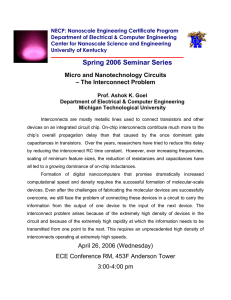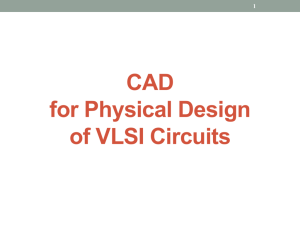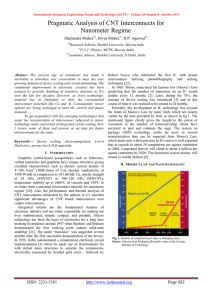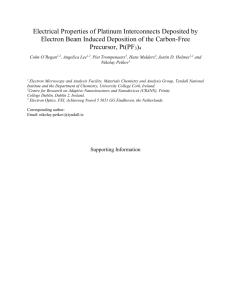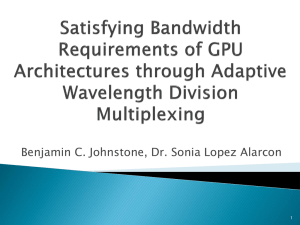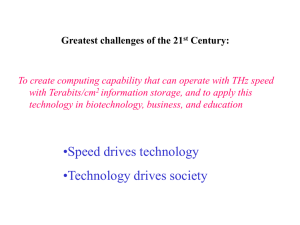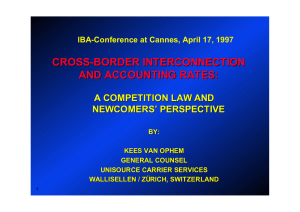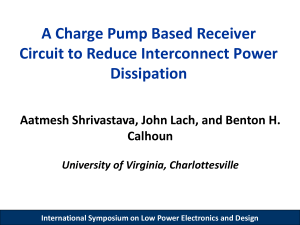New Trend
advertisement
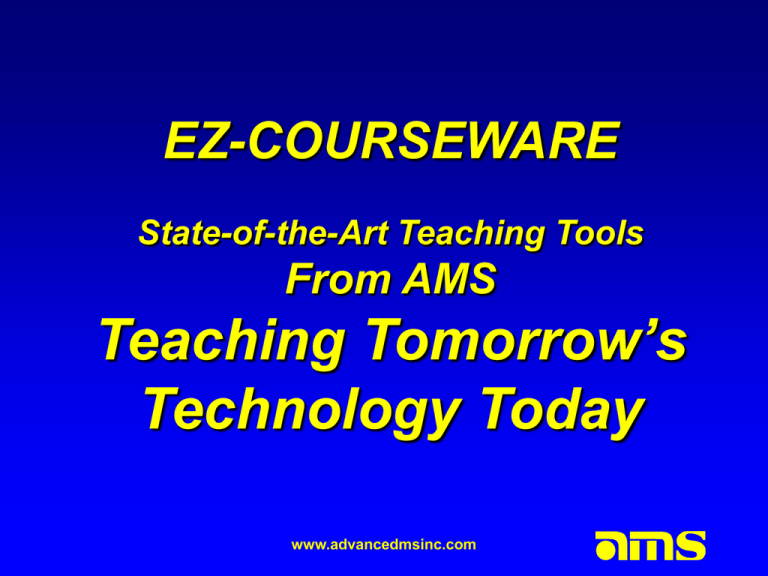
EZ-COURSEWARE State-of-the-Art Teaching Tools From AMS Teaching Tomorrow’s Technology Today www.advancedmsinc.com New Trends in VLSI Design www.advancedmsinc.com Processor Performance www.advancedmsinc.com Why is Performance Improving? • Better circuit design • More memory, cache and register • More parallelism (wider data bus, pipelining, etc.) • Transistors are switching faster!!!! www.advancedmsinc.com Simple Scaling Full Parameter Scaling Dimensions: width, length, oxide thickness Voltages: supply, threshold Intrinsic gate delay Gate Capacitance Current per device Power dissipationwww.advancedmsinc.com per gate Constant Voltage Scaling 1/S 1/S 1/S 1 1/S 1/S 1/S 1/S2 1/S2 1/S S S Technology (mm) 1.5 1.0Area 0.8 Chip 0.35 0.25 Remark: mm = mircon Intel 386 DX Intel 486 DX Pentium Pentium Pro & Pentium II 0.6 1cm2 www.advancedmsinc.com Transistor Count vs. Year www.advancedmsinc.com Average Transistor Price vs. Year www.advancedmsinc.com Can Scaling Continue in Future? Year 1989 1992 1995 1997 1999 Technology 0.65 0.5 0.35 0.25 0.18 • Scaling works well in the past (mm) • In order to keep scaling to work in the future, many technical problems need to be solved. www.advancedmsinc.com The Roadmap • National Technology Roadmap for Semiconductors (NTRS) • Called ITRS (International TRS) since 4th Edition Year of Publication Ed • Projection1st of future technology 1992requirements for the next 15 years. 2nd 1994 3rd 4th 1997 1999 www.advancedmsinc.com Roadmap Overview • Focus Technology Working Groups – – – – – – – Design & Test Process Integration, Devices & Structures Front End Process Lithography Interconnect Factory Integration Assembly & Packaging – – – – Environment, Safety & Health Defect Reduction Metrology Modeling & Simulation • Crosscut Technology Working Groups www.advancedmsinc.com Technology Characteristics Year 1999 2001 2003 Technology 0.18 0.15 0.13 (mm) Density 6.2M 10M 18M 2 (#trans./cm ) Chip size 3.40 3.85 4.30 (cm2) Power 90 110 130 (W) Frequency 1250 1500 2100 (MHz) # routing 6-7 7 7 layers 2006 2009 0.1 0.07 2012 0.05 39M 84M 180M 5.20 6.20 7.50 160 170 175 3500 6000 10000 7-8 8-9 9 *Data for high-performance microprocessor *Data from 97 Edition of Roadmap www.advancedmsinc.com Technical Problems with Future VLSI Technology www.advancedmsinc.com Too much transistors • Design are too complicated • No way to do it manually • Solutions: – CAD – Design hierarchically – Design reuse www.advancedmsinc.com Area, Performance, Power, Noise • Important to keep area small. • How to achieve such a good performance? • Power consumption is huge. Heat dissipation is also a problem. • Both Capacitive and Inductive Noises are not ignorable now. • Solutions: – Physical Design is an appropriate stage to handle all these. www.advancedmsinc.com – Many research needs to be done. Interconnect Area • Too many interconnects. • Occupy too much area. • Solution: – More interconnect layers. – Made possible by Chemical-Mechanical Polishing (CMP). – Note that more layers doesn’t necessarily mean less interconnect area. – Also, routing is no longer a 2-D problem. Hence, new CAD algorithms needed. www.advancedmsinc.com SEM Photo of Metal Layers www.advancedmsinc.com Cross-Section of Metal Layers www.advancedmsinc.com 40 35 Interconnect Delay Interconnect Delay Gate Delay Delay (ps) 30 25 20 15 10 5 0 0.65 0.5 1989 1992 0.35 1995 0.25 0.18 0.13 0.1 1998 2001 2004 2007 Technology Generation(mm) Source: SIA Roadmap 97 19 Interconnect Delay • Dominating factor in determining circuit performance nowadays. • Solutions: – Copper wire – Low-k (dielectric constant) material – Interconnect Optimization at physical design www.advancedmsinc.com Design Planning • Need to plan ahead during the early stages of VLSI design cycle. • Need to take physical design into consideration early. • Many research needs to be done. www.advancedmsinc.com Summary • Technology Trend: – – – – Transistors are smaller. Transistors and Interconnects are denser. Chip areas are larger. Number of metal layers are more. • Problems: – – – – Design complexity. Tradeoff of Area, Performance, Power, Noise. Interconnect area and Interconnect delay. Increasing planning requirements. www.advancedmsinc.com www.advancedmsinc.com
